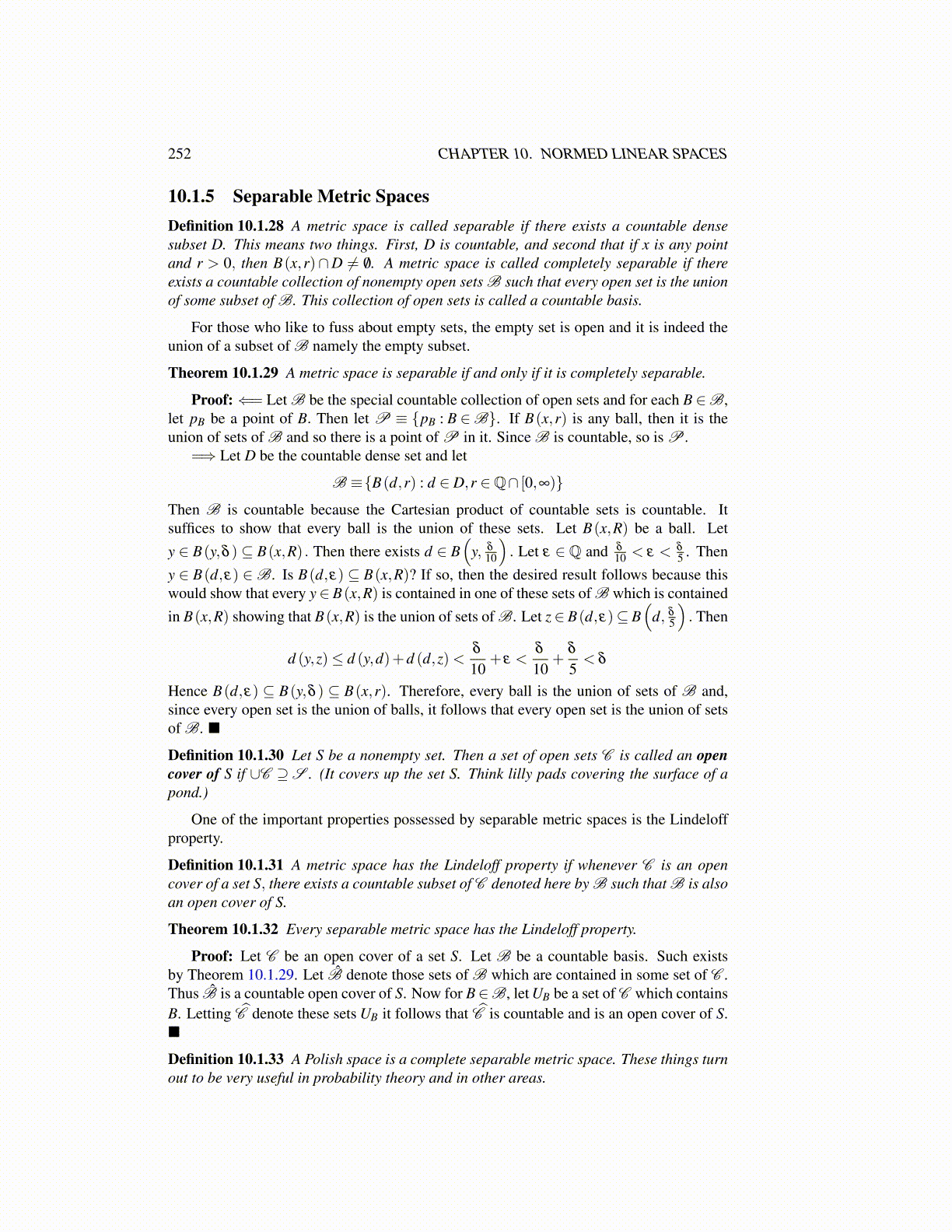
252 CHAPTER 10. NORMED LINEAR SPACES
10.1.5 Separable Metric SpacesDefinition 10.1.28 A metric space is called separable if there exists a countable densesubset D. This means two things. First, D is countable, and second that if x is any pointand r > 0, then B(x,r)∩D ̸= /0. A metric space is called completely separable if thereexists a countable collection of nonempty open sets B such that every open set is the unionof some subset of B. This collection of open sets is called a countable basis.
For those who like to fuss about empty sets, the empty set is open and it is indeed theunion of a subset of B namely the empty subset.
Theorem 10.1.29 A metric space is separable if and only if it is completely separable.
Proof: ⇐= Let B be the special countable collection of open sets and for each B ∈B,let pB be a point of B. Then let P ≡ {pB : B ∈B}. If B(x,r) is any ball, then it is theunion of sets of B and so there is a point of P in it. Since B is countable, so is P .
=⇒ Let D be the countable dense set and let
B ≡{B(d,r) : d ∈ D,r ∈Q∩ [0,∞)}
Then B is countable because the Cartesian product of countable sets is countable. Itsuffices to show that every ball is the union of these sets. Let B(x,R) be a ball. Lety ∈ B(y,δ ) ⊆ B(x,R) . Then there exists d ∈ B
(y, δ
10
). Let ε ∈ Q and δ
10 < ε < δ
5 . Theny ∈ B(d,ε) ∈B. Is B(d,ε) ⊆ B(x,R)? If so, then the desired result follows because thiswould show that every y∈ B(x,R) is contained in one of these sets of B which is containedin B(x,R) showing that B(x,R) is the union of sets of B. Let z∈ B(d,ε)⊆ B
(d, δ
5
). Then
d (y,z)≤ d (y,d)+d (d,z)<δ
10+ ε <
δ
10+
δ
5< δ
Hence B(d,ε) ⊆ B(y,δ ) ⊆ B(x,r). Therefore, every ball is the union of sets of B and,since every open set is the union of balls, it follows that every open set is the union of setsof B. ■
Definition 10.1.30 Let S be a nonempty set. Then a set of open sets C is called an opencover of S if ∪C ⊇S . (It covers up the set S. Think lilly pads covering the surface of apond.)
One of the important properties possessed by separable metric spaces is the Lindeloffproperty.
Definition 10.1.31 A metric space has the Lindeloff property if whenever C is an opencover of a set S, there exists a countable subset of C denoted here by B such that B is alsoan open cover of S.
Theorem 10.1.32 Every separable metric space has the Lindeloff property.
Proof: Let C be an open cover of a set S. Let B be a countable basis. Such existsby Theorem 10.1.29. Let B̂ denote those sets of B which are contained in some set of C .Thus B̂ is a countable open cover of S. Now for B∈B, let UB be a set of C which containsB. Letting Ĉ denote these sets UB it follows that Ĉ is countable and is an open cover of S.■
Definition 10.1.33 A Polish space is a complete separable metric space. These things turnout to be very useful in probability theory and in other areas.